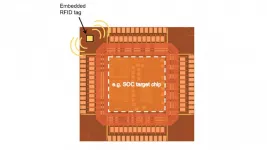Smaller chips open door to new RFID applications
2021-05-12
(Press-News.org) Researchers at North Carolina State University have made what is believed to be the smallest state-of-the-art RFID chip, which should drive down the cost of RFID tags. In addition, the chip's design makes it possible to embed RFID tags into high value chips, such as computer chips, boosting supply chain security for high-end technologies.
"As far as we can tell, it's the world's smallest Gen2-compatible RFID chip," says Paul Franzon, corresponding author of a paper on the work and Cirrus Logic Distinguished Professor of Electrical and Computer Engineering at NC State.
Gen2 RFID chips are state of the art and are already in widespread use. One of the things that sets these new RFID chips apart is their size. They measure 125 micrometers (μm) by 245μm. Manufacturers were able to make smaller RFID chips using earlier technologies, but Franzon and his collaborators have not been able to identify smaller RFID chips that are compatible with the current Gen2 technology.
"The size of an RFID tag is largely determined by the size of its antenna - not the RFID chip," Franzon says. "But the chip is the expensive part."
The smaller the chip, the more chips you can get from a single silicon wafer. And the more chips you can get from the silicon wafer, the less expensive they are.
"In practical terms, this means that we can manufacture RFID tags for less than one cent each if we're manufacturing them in volume," Franzon says.
That makes it more feasible for manufacturers, distributors or retailers to use RFID tags to track lower-cost items. For example, the tags could be used to track all of the products in a grocery store without requiring employees to scan items individually.
"Another advantage is that the design of the circuits we used here is compatible with a wide range of semiconductor technologies, such as those used in conventional computer chips," says Kirti Bhanushali, who worked on the project as a Ph.D. student at NC State and is first author of the paper. "This makes it possible to incorporate RFID tags into computer chips, allowing users to track individual chips throughout their life cycle. This could help to reduce counterfeiting, and allow you to verify that a component is what it says it is."
"We've demonstrated what is possible, and we know that these chips can be made using existing manufacturing technologies," Franzon says. "We're now interested in working with industry partners to explore commercializing the chip in two ways: creating low-cost RFID at scale for use in sectors such as grocery stores; and embedding RFID tags into computer chips in order to secure high-value supply chains."
INFORMATION:
The paper, "A 125μm×245μm Mainly Digital UHF EPC Gen2 Compatible RFID tag in 55nm CMOS process," was presented April 29 at the IEEE International Conference on RFID. The paper was co-authored by Wenxu Zhao, who worked on the project as a Ph.D. student at NC State; and Shepherd Pitts, who worked on the project while a research assistant professor at NC State.
The work was done with support from the National Science Foundation, under grant 1422172; and from NC State's Chancellor's Innovation Fund.
[Attachments] See images for this press release:

ELSE PRESS RELEASES FROM THIS DATE:
2021-05-12
Meat that is certified organic by the U.S. Department of Agriculture is less likely to be contaminated with bacteria that can sicken people, including dangerous, multidrug-resistant organisms, compared to conventionally produced meat, according to a study from researchers at the Johns Hopkins Bloomberg School of Public Health.
The findings highlight the risk for consumers to contract foodborne illness--contaminated animal products and produce sicken tens of millions of people in the U.S. each year--and the prevalence of multidrug-resistant organisms that, when they lead to illness, can complicate treatment.
The researchers found that, compared to conventionally processed meats, organic-certified meats were 56 percent less likely to be contaminated with ...
2021-05-12
Loss of smell, or anosmia, is one of the earliest and most commonly reported symptoms of COVID-19. But the mechanisms involved had yet to be clarified. Scientists from the Institut Pasteur, the CNRS, Inserm, Université de Paris and the Paris Public Hospital Network (AP-HP) determined the mechanisms involved in the loss of smell in patients infected with SARS-CoV-2 at different stages of the disease. They discovered that SARS-CoV-2 infects sensory neurons and causes persistent epithelial and olfactory nervous system inflammation. Furthermore, ...
2021-05-12
Many people live with chronic pain, and in some cases, cannabis can provide relief. But the drug also can significantly impact memory and other cognitive functions. Now, researchers reporting in ACS' Journal of Medicinal Chemistry have developed a peptide that, in mice, allowed Δ9-tetrahydrocannabinol (THC), the main component of Cannabis sativa, to fight pain without the side effects.
According to the U.S. Centers for Disease Control and Prevention, about 20% of adults in the U.S. experienced chronic pain in 2019. Opioids, the mainstay for ...
2021-05-12
Alexandria, Va., USA -- COVID-19 was declared a global pandemic in March 2020 and given an incomplete understanding of the transmission of SARS-CoV-2 at that time, the American Dental Association recommended that dental offices refrain from providing non-emergency services. As a result, 198,000 dentists in the United States closed their doors to patients. The study "Sources of SARS-CoV-2 and Other Microorganisms in Dental Aerosols," published in the Journal of Dental Research (JDR), sought to inform infection-control science by identifying the source of bacteria and viruses in aerosol generating dental procedures.
Researchers at The Ohio State University College of Dentistry, Division of Periodontology, Columbus, USA, tracked the origins of microbiota in aerosols generated during treatment ...
2021-05-12
Are you empathic, generous and altruistic? In short, do you possess that specific personality trait defined as agreeableness in the language of psychologists? New research from SISSA recently published in the journal NeuroImage sheds light on brain mechanisms underlying this trait.
The study showed that detached and individualistic subjects seem to process information associated with social and non-social contexts in similar ways, as demonstrated by similar activation patterns in the prefrontal cortex, whereas in more agreeable subjects the activation patterns ...
2021-05-12
Peri-implantitis, a condition where tissue and bone around dental implants becomes infected, besets roughly one-quarter of dental implant patients, and currently there's no reliable way to assess how patients will respond to treatment of this condition.
To that end, a team led by the University of Michigan School of Dentistry developed a machine learning algorithm, a form of artificial intelligence, to assess an individual patient's risk of regenerative outcomes after surgical treatments of peri-implantitis.
The algorithm is called FARDEEP, which stands for Fast and Robust Deconvolution of Expression ...
2021-05-12
When Museums closed their doors in March 2020 for the first COVID-19 lockdown in the UK a majority moved their activities online to keep their audiences interested. Researchers from WMG, University of Warwick have worked with OUMNH, to analyse the success of the exhibitions, and say the way Museums operate will change forever.Caption: Compton Verney's homepage for the Cranach exhibition which opened in March 2020 Credit: Compton Verney
The cultural impact of the COVID-19 pandemic has been analysed by researchers from WMG, University of Warwick in collaboration with OUMNH (Oxford University Museum of Natural History) who in the paper, 'Digital Responses ...
2021-05-12
An international research team led by the University of Cologne has succeeded for the first time in connecting several atomically precise nanoribbons made of graphene, a modification of carbon, to form complex structures. The scientists have synthesized and spectroscopically characterized nanoribbon heterojunctions. They then were able to integrate the heterojunctions into an electronic component. In this way, they have created a novel sensor that is highly sensitive to atoms and molecules. The results of their research have been published under the title 'Tunneling current modulation in atomically precise graphene nanoribbon heterojunctions' in Nature Communications. The work was carried out in close cooperation between the Institute for ...
2021-05-12
BOSTON - (May 12, 2021) - Scientists are rapidly gathering evidence that variants of gut microbiomes, the collections of bacteria and other microbes in our digestive systems, may play harmful roles in diabetes and other diseases. Now Joslin Diabetes Center scientists have found dramatic differences between gut microbiomes from ancient North American peoples and modern microbiomes, offering new evidence on how these microbes may evolve with different diets.
The scientists analyzed microbial DNA found in indigenous human paleofeces (desiccated excrement) from unusually dry caves in Utah and northern Mexico with extremely ...
2021-05-12
Surface plasmon polaritons (SPPs) are highly localized surface waves on the interface between metal and dielectric in the optical frequency band. SSPs do not naturally exist in the microwave and terahertz frequencies, so "spoof" surface plasmon polaritons (SSPPs) are necessary for operations in those lower frequency bands.
Like optical SPPs, microwave SSPPs exhibit highly localized electromagnetic fields, subwavelength resolution, and extraordinary field confinement. Therefore, SSPP transmission lines (TLs) have been proposed as novel types of microwaveguides that offer new solutions for miniaturization, ...
LAST 30 PRESS RELEASES:
[Press-News.org] Smaller chips open door to new RFID applications



